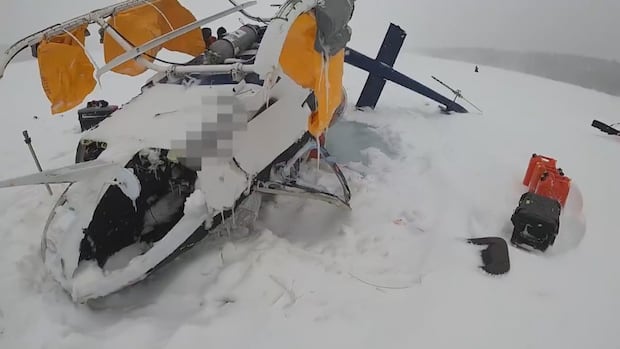TSB report on remote Labrador helicopter crash says pilot attempted to land on ice in low visibility
Pilot was heading to Nunavut for scientific research

A helicopter pilot was trying to make a precautionary landing on a frozen lake in remote Labrador during bad winter weather when they crash landed in May 2024.
That's the conclusion of a Transportation Safety Board of Canada (TSB) investigation into a helicopter collision on Lewis Lake, about 50 kilometres southwest of Postville, on Labrador's north coast.
The pilot — who was the only person travelling in the Custom Helicopters aircraft — had planned to fly from Happy Valley-Goose Bay in central Labrador, to Nunavut to participate in the Polar Continental Shelf Program's scientific research.
The pilot arrived at the Goose Bay Airport on April 28, according to the TSB report, and for each of the next three days had planned to fly the 860-nautical-mile route, but each day felt the conditions weren't suitable.
Finally, on May 2, he changed his mind and took to the air despite reduced visibility and cloud ceilings due to a light snowfall.
The pilot flew toward Hopedale at a reduced speed after determining conditions would improve along the Labrador coast.
Visibility decreased as the pilot headed toward Postville, so he made a 180-degree turn southwest. When visibility decreased once again after an attempt to head closer toward his destination, he made another 180-degree turn.
That's when the pilot found himself near a frozen Lewis Lake, and tried to make a precautionary landing, the report said.
"The poor visibility caused the pilot to misjudge his height above ground in the descent," the TSB report reads. "The helicopter struck the frozen surface of Lewis Lake [...] while travelling parallel to, and about 700 feet from, the north shoreline of the lake."
The helicopter rolled upside down after hitting the ice.
Safety and survival
The helicopter pilot was operating a visual flight rules flight, meaning he depended primarily on eyesight and clear conditions for navigation. He also used navigation charts displayed on a tablet app.
"The aircraft had a Sentry Plus portable automatic dependent surveillance-broadcast receiver on board that incorporated a global positioning system receiver and an attitude and heading reference system; however, the pilot did not turn it on or pair it to the tablet," the report said.
According to Transport Canada, aircraft from the Manitoba-based Custom Helicopters are allowed to operate in some reduced-visibility conditions. Its procedures direct pilots not to fly over snow or ice-covered surfaces with "poor visual reference to the ground."
The helicopter's landing gear skids, rotor assembly and tail boom were all heavily damaged on impact, and its windscreens and chin bubbles were shattered.
The pilot was picked up by search and rescue crews around 3:30 p.m. on May 2, and changed from his wet clothes to dry clothes while taking shelter in the wreckage as he waited. He only had minor injuries.
The TSB report said Custom Helicopters developed training scenarios for visual flight rules, and the board made recommendations to pilots heading on similar journeys.
"Pilots are reminded to plan ahead, consider strategies to avoid adverse weather, and have alternate plans should such weather be encountered."
Download our free CBC News app to sign up for push alerts for CBC Newfoundland and Labrador. Sign up for our daily headlines newsletter here. Click here to visit our landing page.



